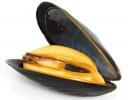Polymer clay: tricks at work. Tips for working with polymer clay How to prepare clay for modeling - Elutriation of clay
Almost all beginners who have only recently started working with polymer clay may have some questions related to the use of this material and modeling out of him. Many masters who have been modeling for several years still remember those times when they were just starting to get involved in this activity, and they also had questions, the answers to which had to be searched all over the Internet.
How to soften polymer clay?
Polymer clay, after thorough kneading, should feel moderately soft to the touch, so that it is convenient to sculpt from it. It should not stick to your hands, but it should not crumble either. Sometimes it happens that plastic (polymer clay), after a long storage or even recently bought in a store, turns out to be very hard to the touch, it is almost impossible to knead it and make something out of it. This means that there is not enough plasticizer in the clay, which is why it is so hard. To make it softer and more plastic, you can use a special liquid - softener for polymer clay. But it is not very cheap, so it is often used only by professionals.

For beginners, we can offer a cheaper clay softening method. To do this, you need ordinary Vaseline. You can soften the clay with it as follows: take a piece of polymer clay and apply one or two drops of petroleum jelly to it, now carefully knead the clay with the petroleum jelly until it becomes plastic. The main thing is not to add too much Vaseline, otherwise the clay may become too soft.
How to make polymer clay harder?
Another problem is too soft polymer clay, which literally stretches and sticks to hands very much. In such clay there is more plasticizer than necessary. Therefore, it is necessary to reduce its quantity. To do this, shape your clay into a flat cake and place it on a clean sheet of white paper. Cover with the same sheet of paper on top and press down with your hands, then put something hard on top of the paper with clay. After a couple of hours, carefully remove the paper from the clay. You will see greasy traces on the paper - this is the plasticizer soaked into it. Now knead the clay. You will notice that it has become more solid. If it is still soft, you can repeat the procedure with paper.

How to store polymer clay?
First of all, remember that polymer clay should not be stored near a heater or other heat source, and should not be frozen. Open packs or individual pieces of polymer clay should be stored in such a way that air access is limited, otherwise, over time, the plasticizer will evaporate and the plastic will harden. To prevent this from happening, keep all open blocks of clay tightly wrapped in cling film or foil. You can also use tightly closed small bags with a zip fastener to store pieces of clay.
How to avoid leaving fingerprints on the surface of products?
Even a beautiful product will look damaged if your fingerprints remain on its surface. To ensure that the surface is smooth and there are no prints on it, sculpt in rubber medical gloves or fingertips.

How to roll out polymer clay?
For rolling out polymer clay, you can find special acrylic rolling pins in craft stores, but, as a rule, the price of rolling pins is quite high. Although, for starters, such a rolling pin can be completely replaced with a glass bottle from kefir or from another drink. The main thing is that the bottle has a cylindrical shape and a smooth surface.

How to bake polymer clay?
First of all, I’ll tell you on what surface you can bake polymer clay products. It can be baked on thick cardboard, on foil, on a ceramic or glass plate, on tiles, in a metal box. Also, products, if necessary, can be baked on pieces of cotton wool or paper napkins (to preserve the shape of the product). At the same time, place a plate (or other surface) with products in a cellophane sleeve for baking and tie the sleeve on both sides, then put it in the oven. Due to the fact that the clay will be closed in the sleeve, the smell from the clay will not be heard during baking, and no substances that are released from the clay during baking will settle on the walls of the oven. As for the temperature and duration of baking, this information is always on the packaging of the clay, so study it carefully.

What kind of varnish to coat polymer clay jewelry?
Some decorations and others polymer clay products look more beautiful if they have a shiny glossy surface. To obtain such a surface, the product can be coated with a glossy varnish. But it must be special varnish, designed specifically for polymer clay. Products cannot be coated with any other varnishes. And in no case do not cover polymer clay with nail polish, as after a while the product will begin to stick due to the reaction of polymer clay and the solvent contained in the varnish.
We hope these recommendations are helpful to you. Polymer clay this is an amazing material that allows you to create the most diverse and unusual crafts. It can be decorations (how to make polymer clay earrings), figurines, magnets, key chains, vases, Christmas decorations and much more that your imagination tells you. Therefore, we wish you creative success!
Especially for the website Lessons of Needlework katstarkova.
Hereditary master potters of Ancient Rus' also had their own clay pits lined with log walls - clay pots. The clay was stored in them for at least three months, and most often for several years.
How to prepare clay for modeling
Unfortunately, we do not have such time in reserve, we will not wait long for the clay to “ripen”. Therefore, to the question we will find another answer. But still, we will put our prepared raw materials in a large enameled bowl and put it outdoors or indoors, covering it with a damp cloth, and on top with polyethylene, periodically adding water to the clay mass.
Leave the bulk to lie and "ripen", and a small amount, which we need in the near future, is necessary.
How to prepare clay for modeling - Sifting clay.
In any clay there are extraneous inclusions - pebbles, grass, roots, knots, etc. You need to get rid of them by crushing and sifting everything.
Wet clay is laid out on a piece of cloth, a plank or a stack of newspapers in an even layer, then dried in the open air, in a warm stove or on a radiator, and put into a strong canvas bag, beaten with a wooden mallet.
Sift the crushed clay into a bucket through a fine sieve. Pebbles, chips, etc. will remain on it. They must be thrown away periodically so that the sieve does not become clogged.
It is convenient to leave a part of the clay in the form of a powder. It can be added to the clay mass when it urgently needs to be made less liquid, and there is no time for drying. Keep clay powder tightly closed.
How to prepare clay for modeling - Elutriation of clay.
Some potters, instead of grinding and drying, pass the clay through a meat grinder with large holes. in adobe
industries use this or a similar “tonschneider” device. This method helps to make the material as homogeneous as possible. But do not forget that in this case the impurities are not removed, but crushed, and, moreover, a lot of air bubbles get into the clay, which must be disposed of by increased kneading.
Elutriating the clay, we not only clean it, but also make it more oily and plastic. This is done most often with lean clays containing a lot of sand.
Fill the bucket 1/3 full with clay powder. Add water to the top and stir with a wooden spatula or stick.
Let the mass stand for about a day. Then carefully remove light debris floating on the surface. If the water is clear on top, carefully drain it with a rubber hose. Carefully scoop out a layer of liquid clay suitable for modeling and pour it into another bowl. At the same time, try not to grab the bottom layer with a scoop - settled pebbles and sand. If your clay is too thin, then this Procedure should be repeated one more time. Excess sand will settle to the bottom.
The liquid clay obtained after elution is not yet suitable for modeling. If you try to sculpt from it, you will dirty yourself and everything around. Lay out the clay
in an even layer about 1-1.5 cm thick on a stack of newspapers or rags: let dry. And even better if you have a gypsum board - after all, gypsum absorbs water from clay very well. Turn the clay cake from time to time and make sure that it does not dry out. Check the quality: if the clay doesn't stick to your hands, it's almost ready to be sculpted. And if it sticks and does not dry for a very long time? So, too fat and she needs lean supplements.
Slimming supplements. The clay that falls into our hands does not always meet our requirements. Most often in ancient times, loess silt was used. Because it contained a lot of different impurities, and the master potter only needed to get rid of products that were unnecessary for a particular type.
The composition of the clay was determined depending on the purpose for which it would be used in everyday life. There were two grades of clay kneading: coarse, with sand, and clean, with no impurities at all. The first was used for kitchen products, the second - for tableware. Various thinners were added to the clay intended for kitchen utensils. They were needed to reduce the shrinkage of the clay during drying and to avoid cracking of the walls of the vessels during the firing process. In ancient China, a variety of leaners were used: finely chopped grass, talc, crushed pearl oyster shells, fish bones, crushed fireclay left over from old ceramics, quartz, quartzite and other minerals. But the sand was most widely used for this, which is divided by quality into 2 grades: fine and coarse (about 0.7 mm in diameter). Sand is used as a lean additive even now. To do this, it must be washed and dried, and then added to the clay mass. You can also use sawdust, as well as fireclay.
fireclay- these are crushed particles of fired ceramics or refractory bricks (using the latter, you can get refractory ceramics). To prepare fireclay, they are crushed and then sifted through a sieve, removing ceramic dust. What remains in the sieve is chamotte. It should be added to clay dough as a lean additive no more than 1/5 of the total mass.
Clay, to which up to 50% fireclay is added, is called fireclay mass. It makes very beautiful and strong decorative ones.
Today, more and more tools for the garden and garden are made from an alloy based on titanium ...
Show me a man who would be happy to dig beds? It was digging, not hoeing. Needless to say, this job is not easy. And so that digging does not turn into hard work, carefully look at the most important tool - a shovel. What is she? What is the blade made of? What is the length of the stem? Are your hand tools comfortable, durable and ergonomic? These and many other questions were asked to me at the meeting by Pavel Shakal, a sales specialist for gardening and gardening equipment of one of the metropolitan firms.
So, shovels are different. It is advisable to have a whole set of them. With a pointed (that is, triangular), straight or slightly rounded blade, long and short, wide and narrow. If virgin land awaits you, look for a bayonet shovel with a sharp triangular “nose”. For light soils, a rectangular blade is suitable.
The blade is worth talking about in more detail. The quality of soil cultivation largely depends on the material from which it is made. The cheapest tools are made of ordinary steel, or ferrous metal. Tap on the blade: the louder the sound, the stronger and lighter the shovel will be.
There are commercially available shovels made of lightweight composite material with a stainless steel blade. With a blade sharpened on one side like the teeth of a saw. With such a tool it is easy to dig neglected areas overgrown with weeds, to work on heavy clay or soddy soils. Stainless steel is reliable, the earth is easily cleaned from it, and dampness is not terrible.
What do you know about the "American" - a shovel with a curved blade? American farmers have been using it for more than 200 years and will never change it to a bayonet. Why? It turns out that it is very easy and convenient to work with it. Summer residents-pensioners have long appreciated the advantages of the "American": no need to bend over, and therefore less stress on the spine. The result is better than if you were digging with an ordinary shovel.
The blade of the "American" is covered with Teflon. Therefore, during operation, wet earth (even clay) does not stick. The stalk is made of eucalyptus, which is also important. There are also metal and plastic ones. Wood (oak or aspen) absorbs moisture well, so sweaty hands do not slip. And accordingly, you can not be afraid of corns. It will protect against calluses and a foam rubber ring worn on the handle.
Today, more and more gardening tools are made from a titanium-based alloy. Yes, yes, the very one from which spaceships are made. Lightness and strength are the main advantages of this material. A steel shovel, for example, weighs more than a kilogram, and a titanium shovel only 400 g. Titanium is only slightly heavier than aluminum, but it is 3 times stronger. Thanks to its unique properties, wet soil does not stick to the tool, and the service life is increased several times. Titanium helpers never rust or corrode. And they are superior in durability to stainless steel. One disadvantage of such shovels is that they are very expensive. But there is still something to pay for: the blade is durable, does not bend, does not get dull, and keeps sharpening well. And so that you are not deceived when buying, check the quality of the inventory by simply running a metal object along the edge of the tool. No traces left - scratches and notches? Feel free to buy! Titanium steel does not scratch.
What else should you pay attention to when choosing a shovel? For attaching the blade to the handle. The best option is bolts or a metal guy ring (like a braid). If the shovel is simply planted on the handle and not fixed by anything, then in a month or two it will loosen, fly off, or even worse, break.
And further. To work easily and pleasantly, the fingers should freely wrap around the handle. It is possible that some of the shafts will have to be trimmed. Just do not forget to scrape them with glass and clean them with sandpaper. Otherwise, you won't get calluses.
A shovel, like any tool, needs to be looked after. Did you work? Scrub it with a stiff brush or wash off the dirt with water. And then lubricate the blade with vaseline or machine oil. And then you don’t have to spend money on buying a new shovel every year. Moreover, she also needs time (at least one season) to grind and wipe herself in order to begin to easily enter the soil.
Councils "SB"
If you drill several holes with a diameter of 20 mm in an ordinary shovel, then the earth will stick less. An ordinary window handle screwed to the handle of a shovel will greatly facilitate the work of laying out sand or compost.
The shovel must necessarily correspond to the height of the digger, that is, be 10 cm below his shoulder.
Natalia TYSHKEVICH
Well, now let's talk about how to use stamps to work with polymer clay, how to make molds yourself, as well as some others techniques for working with polymer clay.
Now on the market there is a huge variety of molds for working with polymer clay. Stamps greatly simplify the life of designers, and also help to make ordinary things unusual.
Stamps can be used to create decorations for some surfaces, whether it's a photo frame or a switch trim. Also, molds for polymer clay can be used to create some kind of separate item, a medallion or a brooch, for example. Molds for polymer clay are very relevant if you make a lot of the same products. Here you can't do without stamps.
When working with molds for polymer clay, you need to follow some rules. I have written about them before, but I will repeat.
To prevent polymer clay from sticking to the surface of the stamp, use baby powder or starch.
After you have pressed the polymer clay into the stamp, carefully cut off the rest with a knife.
You can also paint the resulting casts with special acrylic paints.
To create a textured surface on a polymer clay product, you can use homemade tools with different interesting surfaces. But here you need to remember that these devices should not be used later for cooking or for eating. Because we do not forget that polymer clay is a product of oil refining. And no matter how environmentally friendly it is, you can’t eat it and out of it.
It will be very useful to rummage through children's toys. Surely there will be a lot of ideas for texturing polymer clay products.
Using colored pencils when working with polymer clay.
Perhaps for someone it will be a discovery, as for me. But it is very good to draw with colored pencils not only on paper or wallpaper, but also on polymer clay.
This does not require any special skills. Here are some recommendations.
- You just need to color the already baked polymer clay.
- It is better to paint on light polymer clay, white or beige. After you have painted, take a cotton cloth and buff the painted surface to even out the colors.
- You also need to remember about the combination of colors, which I already wrote about.
A few tips to further your creativity with polymer clay.
If you have leftover pieces of a wide variety of sausages, do not throw them away. Put them together and twist. Then make a square sausage out of this colored mass. This technique is called mirroring.






